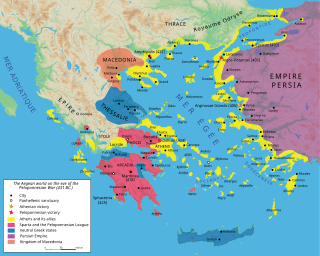
The Delian League, founded in 478 BC, was an association of Greek city-states, numbering between 150 and 330, under the leadership of Athens, whose purpose was to continue fighting the Persian Empire after the Greek victory in the Battle of Plataea at the end of the Second Persian invasion of Greece.

A coin is a small object, usually round and flat, used primarily as a medium of exchange or legal tender. They are standardized in weight, and produced in large quantities at a mint in order to facilitate trade. They are most often issued by a government. Coins often have images, numerals, or text on them. The faces of coins or medals are sometimes called the obverse and the reverse, referring to the front and back sides, respectively. The obverse of a coin is commonly called heads, because it often depicts the head of a prominent person, and the reverse is known as tails.

The Peloponnesian War was an ancient Greek war fought between Athens and Sparta and their respective allies for the hegemony of the Greek world. The war remained undecided for a long time, until the decisive intervention of the Persian Empire in support of Sparta. Led by Lysander, the Spartan fleet, built with Persian subsidies, finally defeated Athens and started a period of Spartan hegemony over Greece.
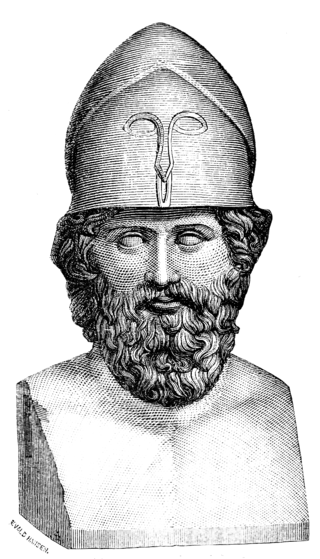
Themistocles was an Athenian politician and general. He was one of a new breed of non-aristocratic politicians who rose to prominence in the early years of the Athenian democracy. As a politician, Themistocles was a populist, having the support of lower-class Athenians, and generally being at odds with the Athenian nobility. Elected archon in 493 BC, he convinced the polis to increase the naval power of Athens, a recurring theme in his political career. During the first Persian invasion of Greece, he fought at the Battle of Marathon, and was possibly one of the ten Athenian strategoi (generals) in that battle.

Milos or Melos is a volcanic Greek island in the Aegean Sea, just north of the Sea of Crete. Milos is the southwesternmost island in the Cyclades group.
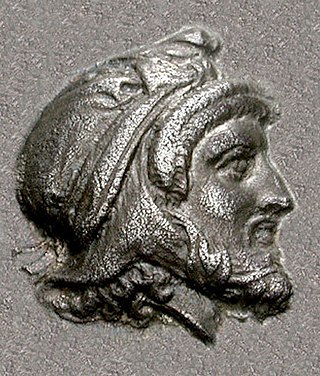
Pharnabazus II was a Persian soldier and statesman, and Satrap of Hellespontine Phrygia. He was the son of Pharnaces II of Phrygia and grandson of Pharnabazus I, and great-grandson of Artabazus I. He and his male ancestors, forming the Pharnacid dynasty, had governed the satrapy of Hellespontine Phrygia from its headquarters at Dascylium since 478 BC. He married Apama, daughter of Artaxerxes II of Persia, and their son Artabazus also became a satrap of Phrygia. According to some accounts, his granddaughter Barsine may have become Alexander the Great's concubine.
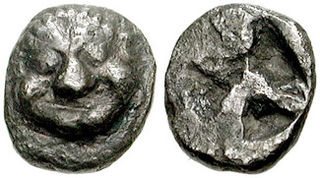
The obol was a form of ancient Greek currency and weight.
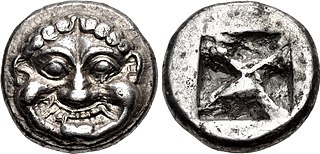
The history of ancient Greek coinage can be divided into four periods: the Archaic, the Classical, the Hellenistic and the Roman. The Archaic period extends from the introduction of coinage to the Greek world during the 7th century BC until the Persian Wars in about 480 BC. The Classical period then began, and lasted until the conquests of Alexander the Great in about 330 BC, which began the Hellenistic period, extending until the Roman absorption of the Greek world in the 1st century BC. The Greek cities continued to produce their own coins for several more centuries under Roman rule. The coins produced during this period are called Roman provincial coins or Greek Imperial Coins.
Roman Republican currency is the coinage struck by the various magistrates of the Roman Republic, to be used as legal tender. In modern times, the abbreviation RRC, "Roman Republican Coinage" originally the name of a reference work on the topic by Michael H. Crawford, has come to be used as an identifying tag for coins assigned a number in that work, such as RRC 367.
The history of money is the development over time of systems for the exchange, storage, and measurement of wealth. Money is a means of fulfilling these functions indirectly and in general rather than directly, as with barter.

The Achaemenid Empire issued coins from 520 BC–450 BC to 330 BC. The Persian daric was the first gold coin which, along with a similar silver coin, the siglos represented the first bimetallic monetary standard. It seems that before the Persians issued their own coinage, a continuation of Lydian coinage under Persian rule is likely. Achaemenid coinage includes the official imperial issues, as well as coins issued by the Achaemenid provincial governors (satraps), such as those stationed in Asia Minor.
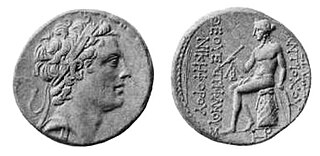
The coinage of the Seleucid Empire is based on the coins of Alexander the Great, which in turn were based on Athenian coinage of the Attic weight. Many mints and different issues are defined, with mainly base and silver coinage being in abundance. A large concentration of mints existed in the Seleucid Syria, as the Mediterranean parts of the empire were more reliant on coinage in economic function.

The tetradrachm was a large silver coin that originated in Ancient Greece. It was nominally equivalent to four drachmae. Over time the tetradrachm effectively became the standard coin of the Antiquity, spreading well beyond the borders of the Greek World. As a result, tetradrachms were minted in vast quantities by various polities in many weight and fineness standards, though the Athens-derived Attic standard of about 17.2 grams was the most common.

In ancient Greece, the drachma was an ancient currency unit issued by many city-states during a period of ten centuries, from the Archaic period throughout the Classical period, the Hellenistic period up to the Roman period under Greek Imperial Coinage. The ancient drachma originated in the Greece around the 6th century BC. The coin, usually made of silver or sometimes gold had its origins in a bartering system that referred to a drachma as a handful of wooden spits or arrows. The drachma was unique to each city state that minted them, and were sometimes circulated all over the Mediterranean. The coinage of Athens was considered to be the strongest and became the most popular.
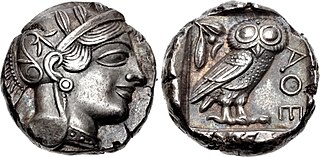
Attic weight, or the Attic standard, also known as Euboic standard, was one of the main monetary standards in ancient Greece. As a result of its use in the coinage of the Athenian empire and the empire of Alexander the Great, it was the dominant weight standard for coinage issued in the Eastern Mediterranean from the fifth century BC until the introduction of the Roman denarius to the region in the late first century BC.

Coinage of the Ptolemaic kingdom was struck in Phoenician weight, also known as Ptolemaic weight. This standard, which was not used elsewhere in the Hellenistic world, was smaller than the dominant Attic weight. Consequentially, Ptolemaic coins are smaller than other Hellenistic coinage. In terms of art, the coins, which were made of silver, followed the example set by contemporary Greek currencies, with dynastic figures being typically portrayed. The Ptolemaic coin making process often resulted in a central depression, similar to what can be found on Seleucid coinage.

Ancient Rhodian coinage refers to the coinage struck by an independent Rhodian polity during Classical and Hellenistic eras. The Rhodians also controlled territory on neighbouring Caria that was known as Rhodian Peraia under the islanders' rule. However, many other eastern Mediterranean states and polities adopted the Rhodian (Chian) monetary standard following Rhodes. Coinage using the standard achieved a wide circulation in the region. Even the Ptolemaic Kingdom, a major Hellenistic state in the eastern Mediterranean, briefly adopted the Rhodian monetary standard.
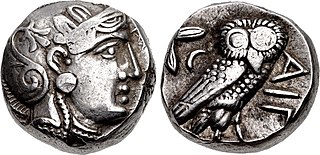
The Kabul hoard, also called the Chaman Hazouri, Chaman Hazouri or Tchamani-i Hazouri hoard, is a coin hoard discovered in the vicinity of Kabul, Afghanistan in 1933. The collection contained numerous Achaemenid coins as well as many Greek coins from the 5th and 4th centuries BCE. Approximately one thousand coins were counted in the hoard. The deposit of the hoard is dated to approximately 380 BCE, as this is the probable date of the least ancient datable coin found in the hoard.
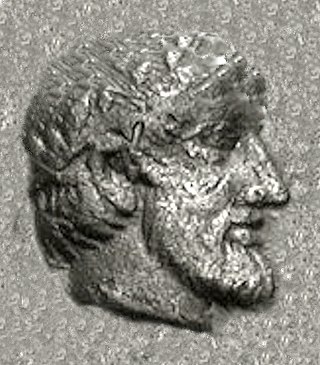
Archeptolis, also Archepolis, was a Governor of Magnesia on the Maeander in Ionia for the Achaemenid Empire circa 459 BCE to possibly around 412 BCE, and a son and successor of the former Athenian general Themistocles.

















